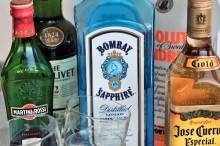Stocking the Perfect Bar,Part 2 “Ingredients”

So now that you’ve loaded up on your basic barware, and you’ve visited our cocktail recipe page and found some favorites, let’s talk about how to stock your bar and keep it ready for action. The goal here is to find the balance between having dozens of bottles you don’t even remember why you bought, versus needing to run to the store every time you want to serve drinks because there’s not one single recipe that you have all the ingredients for.
I have to confess, when I first became excited about bartending I went straight down the “get one of everything” path, and I still have some dusty, unopened decade-old bottles in the back of my bar (the day someone finally wants a drink made with Pernod, I’m ready). The downside of this approach is that, while most liquor generally can be stored indefinitely (if kept tightly capped and in a cool, dark place), we all know booze isn’t cheap. If you’re going to tie up your cash in something just to leave it sitting around, there are probably better investments.
Which liquors you choose to stock in your bar obviously depends what you and your guests like to drink. The trick, as you’re trying out a cocktail that uses new or unfamiliar ingredients, is to buy small until you know it’s a recipe you’ll be making regularly. Once your recipe becomes a hit with your regular guests, stock your bar with the biggest bottles you can afford. If you find the larger bottles to be unwieldy for measuring and mixing, keep the smaller empties and refill them from the big ones. Then, and this is important, keep an eye on your reserves and don’t ever let them fall below what you need to make at least eight servings of your personal classics. That way, you’re assured of being able to serve at least two rounds each to a group of four people. Anyone can plan ahead and stock up for a weekend dinner party. What will impress your friends is your uncanny ability to whip up your best signature cocktail when they drop by unexpectedly on a Wednesday.
As an example, here are the basics of what I make sure are always in supply:
Must-haves
- At least two or three base spirits, especially vodka, gin, bourbon, and tequila.
- At least two or three modifiers, such as Cointreau, Vermouth (both dry and sweet), and Grand Marnier.
- Fresh citrus fruit. I’m absurdly passionate about finding good fruit (watch for a future post on this). If you’re making a cocktail that calls for fresh lemon, lime, or orange juice, the quality of the fruit will make or break your drink. Buy one or two limes, lemons, and/or oranges every time you’re at the grocery store.
- Mixers, such as tonic water, club soda, cranberry juice, and lemonade. Remember to keep an eye on the shelf life of these and re-stock occasionally.
- Ice. Yeah, this one seems obvious. But next time you run to your freezer, shaker in hand, only to find you’re down to the last three cubes because you didn’t bother to re-fill your trays, remember that I told you so.
- Beer and wine, just in case.
Nice-to-haves
- Garnishes, such as martini olives and maraschino cherries. The citrus fruits mentioned earlier can also serve as garnishes in many drinks.
- Accents, such as Angostura bitters, agave nectar, and simple syrup.
With the above basic ingredients on hand, I’m able to cover a wide range of styles and tastes, including Cosmopolitans, gin and vodka martinis, lemon drops, margaritas, and Manhattans, plus a bevy of classic well drinks like gin and tonic, vodka and cranberry, bourbon and…well, ice.
So start with two or three drinks you and your guests regularly enjoy and stockpile the ingredients for those. Expand from there. And get into the habit of regularly scanning your bar inventory and making a mental note of what’s getting low. Think in terms of replenishing the ingredients in your bar just like you would with food in your fridge. It’s easy once it becomes part of your routine.
Cheers!









Leave a Reply